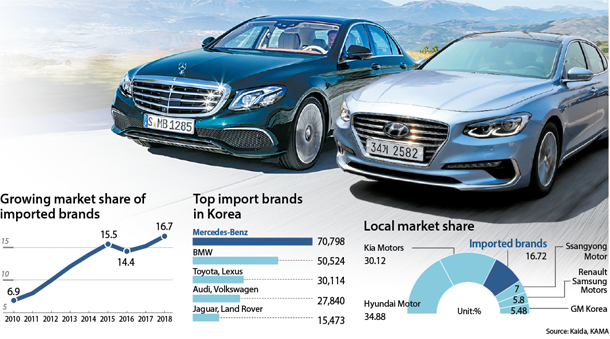Imports headed to a third of market unless local carmakers transform

It not only researched automotive manufacturers but also IT companies that are developing autonomous vehicles, such as Google and Uber, as well as electric vehicle makers such as Tesla.
However, it has been a while since the team has done any research on the local competition.
“Since the domestic market in a larger sense is part of the global market, it’s meaningless,” said an official at Hyundai Motor research center. “The product analysis of local car manufacturers are done by the sales or marketing department.”
In the past, the Korean market was the main focus for Korean car manufacturers. But now their main interest is the cutting edge developments globally.
As of 2017, the United States has the largest ratio of imports, at 49.2 percent of cars sold. Germany is second at 38.7 percent and France third at 31.3 percent. In Japan, relatively few vehicles are imported, with only 7.1 percent of cars brought in from overseas.
Just a decade ago, Korea was in a similar position. The share of imports was under 10 percent. But at the current pace, almost a third of cars in Korea will be imports soon enough.
As such, the battle pits Hyundai and its Kia affiliate against the imports.
The market share of imports was 15.2 percent in 2017, and last year, it further advanced to 16.7 percent. It would have been about 20 percent if not for the trouble faced by BMW, with some of its cars in Korea catching fire.
Last year a total of 1.55 million vehicles, including recreational vehicles, were sold in the country. Hyundai Motor sold 543,652 units while affiliate Kia Motors sold 499,607 units. Together, their market share was 65 percent.
Ssangyong Motor came in third place, at 7 percent, selling 109,140 units, and Renault Samsung Motors took fourth place, at 5.8 percent, selling 90,369 units. GM Korea, which went through a major restructuring including shutting its plant in Gunsan, North Jeolla, in May last year, had a 5.48 percent share, selling 85,432 units.
A total of 260,705 imports were sold.
Mercedes-Benz and BMW controlled about half the import market. Mercedes-Benz sold 70,798 units while BMW sold 50,524 units. The combined market share of these two imported brands was 7.8 percent.
Other German brands, including Audi, Volkswagen and Porsche, sold a combined 107,975 units for combined market share of 6.9 percent.
As such, the biggest competition for the Hyundai Motor Group in the local market is the German brands.
The biggest reason behind the rapid rise of foreign brands in recent years is the difficulty faced by the Korean automotive industry. This year, other than Hyundai Motor Group, the only Korean automotive company that is planning to release new vehicles is Ssangyong Motor.
This is a stark contrast to foreign markets, where new vehicles equipped with the latest technologies are being introduced.
“In the case of Japan, which sells 4.5 million vehicles a year in the domestic market, Toyota has a market share of 40 percent,” said Yoon Dae-sung, Korea Automobile Importers and Distributors Association vice chairman. “It shows how diverse and competitive Japanese local automakers are.”
He said unless the other three automakers - Ssangyong Motor, Renault Samsung Motors and GM Korea - revive from their struggles, they have no other choice but to lose out to imported brands.
“In a year, imported brands introduce 400 new vehicles,” said Lee Hang-gu, a senior researcher at the Korea Institute for Industrial Economics and Trade. “Hyundai Motor introduces 10 or so new cars a year.”
The researcher said as the industry shifts to environment-friendly vehicles and autonomous driving, it will only be a matter of time before the market share of imports hits 30 percent.
“When selling more than 10,000 units a year, a brand gains the ability to self-market, and when it sells more than 30,000 units, it gains the ability to compete on price,” said an official at a foreign brand. “While there are only five companies selling more than 10,000 units a year, if these companies grow, imported market share will experience a steep rise.
“It will be hard for Korean brands without improving product quality,” he concluded.
BY LEE DONG-HYUN [lee.hojeong@joongang.co.kr]










with the Korea JoongAng Daily
To write comments, please log in to one of the accounts.
Standards Board Policy (0/250자)